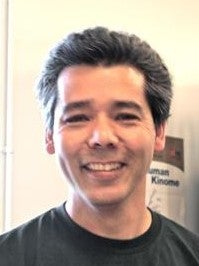
Alan Raetz
Education:
Ph.D. Biochemistry and Molecular Biology, UC Davis 2013
M.S. Biology, California State Univeristy Chico 2005
From: Pacifica, CA
Joined the David Lab: December 2016
Outside of lab: I enjoy riding my motorcycle, skiing, snowboarding, and watching a good basketball game.
Research in David Lab:
Returning to the David Lab as a Postdoctoral Researcher, I continue a project that I began as a graduate student: understanding the molecular mechanism underlying the involvement of MUTYH, an oxidative DNA damage repair enzyme, in the survival of cells to the alkylating agent MNNG. We have evidence that this effect is mediated by MUTYH interactions with AP sites, an important DNA repair intermediate induced by many forms of DNA damage, and thus these findings may tie together unexplained interactions between MUTYH and other forms of DNA damage. (In preparation: “Evidence that MUTYH-mediated cytotoxicity to the alkylating agent N-methyl-N’-nitro-N-nitrosoguanidine (MNNG) is independent of oxidative DNA damage and involves AP site interactions.” Raetz AG, Banda DM, Ma X, Rajavel A, David SS.)
Previous Research Experience:
My Masters thesis project involved using genetic mapping to understand the mechanism of action of the insect repellent DEET (N,N-Diethyl-meta-toluamide). DEET is considered a front-line defense against mosquitoes that carry malaria and other diseases. Since the molecular mechanism of action of DEET was not known, I used both classically mapping techniques and recently developed regression analysis software to map the trait to a region of the X chromosome. My poster presentation of this work won the departmental “Outstanding Student Researcher” award in 2005 and my written Masters’ thesis won “Outstanding Masters Thesis” at Chico State in 2006.
In 2007 I was accepted into the Biochemistry and Molecular Biology graduate program and began working in the David lab in 2008. My primary PhD thesis project in the David Lab involved developing a novel assay in mammalian cells to measure the repair of DNA with a synthetic OG:A lesion, which is the substrate of MUTYH, a base excision repair glycosylase. Lack of proper repair of this lesion due to inherited mutations in MUTYH causes excessive genome-wide mutations, including in APC, KRAS and p53, and typically leads to an early onset form of colorectal cancer. Using mouse embryonic fibroblasts from the knockout mouse model and stable reintroduction of MUTYH cancer variants, my work confirmed that two common cancer-associated variants do have similarly reduced repair and presented controversial findings that the common polymorphism Q324H also has reduced repair ability. I also initially discovered the MUTYH three cysteine motif conserved within vertebrate animals using basic bioinformatics analysis, and this was verified experimentally to be a zinc-binding domain within the critical interdomain connector region of MUTYH that interacts with the 9-1-1 DNA damage response complex and the Sirtuin family human homolog SIRT6. I also provided technical assistance and consultation with the laboratory of Gino Cortopassi in a study of the role of oxidative DNA damage in Frataxin deficiency, which suggests MUTYH is involved in PARP-mediated cell death.
In my first postdoctoral position, I was awarded a National Institute of Aging T32 postdoctoral fellowship via the Buck Institute and studied the nucleotide excision repair pathway protein XPG in the laboratory of Priscilla Cooper at Lawrence Berkeley National Laboratory. In 2015-2016 I worked at Qiagen Bioinformatics (previously Ingenuity) in Redwood City as a bioinformatics software developer.
Links to Papers from David Lab:
Shen Y, McMackin MZ, Shan Y, Raetz A, David S, Cortopassi G. PLoS One, 2016 Mar 8;11(3):e0151026